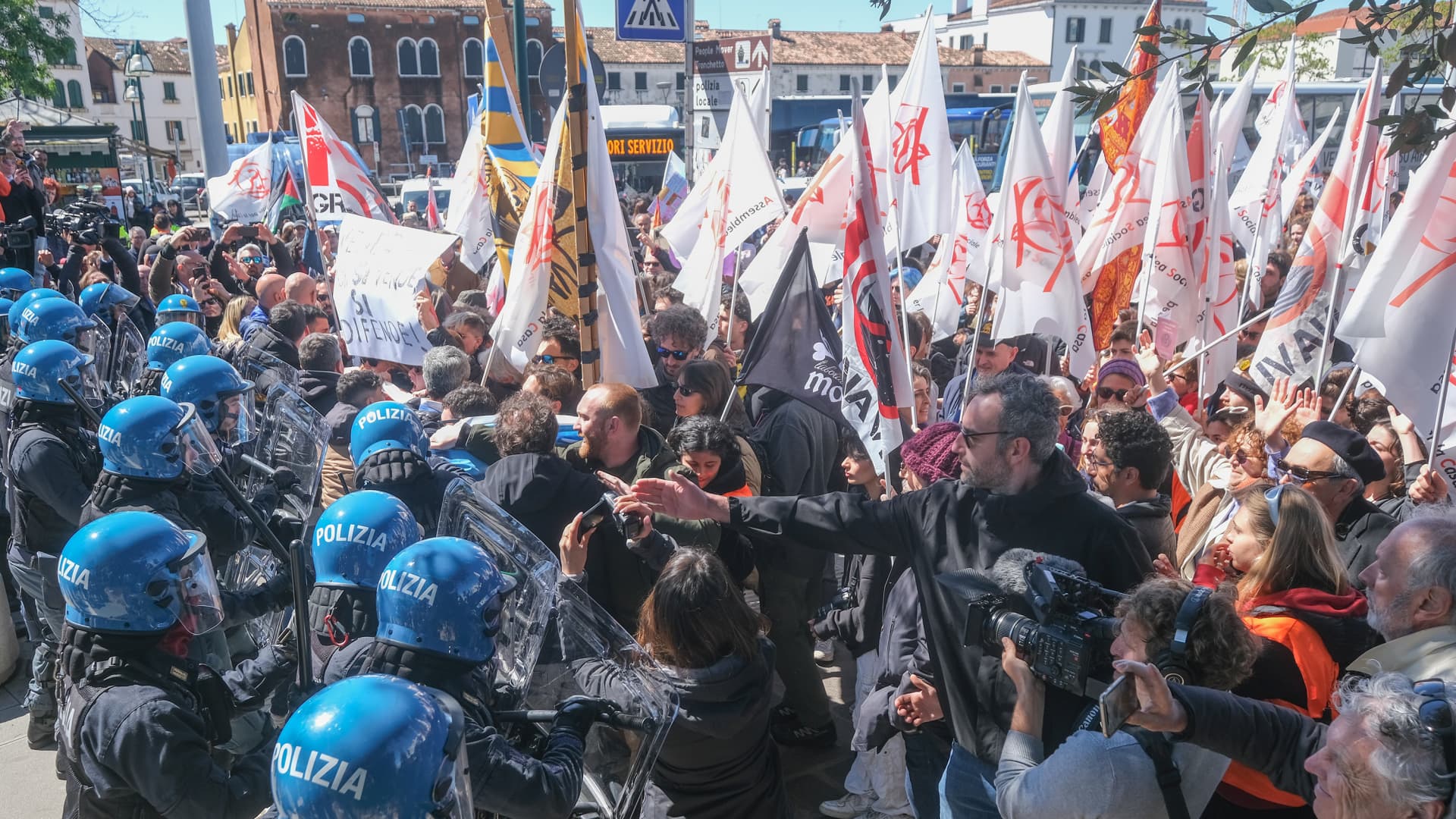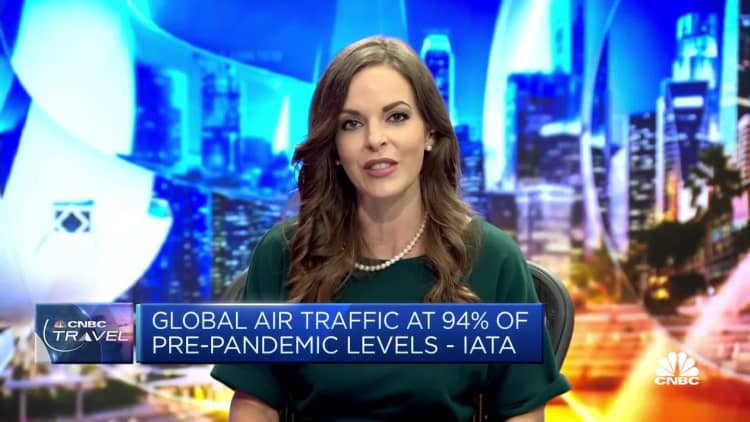
Demonstrators try to break through the blockade created by police officers to enter the city at Piazzale Roma, opposing the charge for tourists to enter the city on April 25, 2024 in Venice, Italy. Today Venice authorities launched a pilot program charging visitors a 5-euro entry fee in the hope that it will discourage at peak time, making the city more livable for its residents.
Stefano Mazzola | Getty Images News | Getty Images
Venice isn’t only sinking, it’s shrinking. In the 1970s, there were about 175,000 residents in Centro Storico, the main island and historic center of Venice. As of last year, that number was below 50,000. What has been growing steadily is tourism, which due to economic and quality-of-life pressure, has been pushing out residents. In fact, there are now more tourist beds in Venice than there are residents. Last year, 20 million people visited, winding their way through its two square miles.
Last week, Venice took action on overtourism, introducing a 5€ fee to day trippers who want to access the city. The aim, Venice’s Mayor Luigi Brugnaro said in a press conference, “is not to close the city, but not let it explode.”
The program, officially launched on April 25 — a historically significant day, as it is both Italy’s Liberation Day and the feast day of the city’s patron saint, St. Mark — took the mayor’s words in a direction he hadn’t intended, with roughly a thousand protestors gathered in Piazzale Roma to oppose the measure, ultimately clashing with police in riot gear.
Residents voiced a range of concerns despite the measure being designed in part to help make their city more livable. They objected to the idea of living in a closed city. Some argued that selling tickets reduces their city to an amusement park – Veniceland. There’s also a central irony, critics say, in a government that at the same time is considering multiple ways to increase tourism, from weighing the idea of cruise ships returning to the lagoon to relaxation of limits on Airbnbs.
A once-in-a-lifetime destination for many travelers from around the world, the most important criticism may be that the cost is unlikely to deter anyone from visiting the city.
“Almost the entire city is against it,” Matteo Secchi, leader of a residents’ activist group, told the Guardian. “You can’t impose an entrance fee to a city; all they’re doing is transforming it into a theme park. … I mean, are we joking?”
On the first day of its implementation, according to data from the mayor’s office, 113,000 people registered, and of those 16,000 paid the fee — others were exempt for various reasons, including hotel stays, being a commuter, a student, or visiting family or friends.
Tourists stand in front of Santa Lucia train station in Venice as they wait to pass controls and buy the five-euro ticket to enter the historic city center on April 25, 2024.
Marco Bertorello | Afp | Getty Images
Despite its many detractors, the day fee is a significant move on the part of Venice’s government to confront the challenge of overtourism, which has become a significant global problem since the pandemic. “This administration is the first one after 30 years of chit-chat on putting a brake to tourism growth that has actually done something,” said Antonio Paolo Russo, who was born in Venice and is a professor of urban geography at Rovira i Virgili University in Tarragona, Spain.
But Russo, offering a view representative of many experts, said the measure seems likely to fall short in terms of effectiveness, and smacks of political gestures, as well as obscure profit motives. “5€ won’t make any difference with such a large demand. … the tourist destiny of the city is scripted in the way it is regulated,” he said.
Venice is the first location to require a ticket to enter a city — to make the city itself the attraction — and legal challenges could still be ahead, in national or EU courts, under laws covering freedom of movement in public places. Other popular tourist destinations have similar programs, but limited to locales and attractions within a city, such as Barcelona’s Park Guell.
Charging tourists to enter popular destinations has worked around the world, but only when there is a clear indication of where the money will go, such as environmental preservation, and when the revenue is kept separate from the general government ledger. Belize’s Protected Area Conservation Trust was a pioneering movement 25 years ago which met these criteria, and programs of this type are on the rise. Bali recently introduced a tourist tax to protect the destination’s environment, nature and culture. Barcelona just increased its tourist tax, while Amsterdam recently raised its tourist tax to the highest rate in Europe. The various taxation schemes being applied to tourists are likely to continue to grow around the world.

But Venice is Venice, and it remains singular in conversations surrounding overtourism, owing in part to its small size, its historic nature, its beauty, and, in many ways, the symbolic impact of seeing enormous cruise ships pulling up to it like Godzilla. All of which makes the stakes for the new fee greater, and the hope for its success higher.
Experts say good data is essential to success in combating overtourism. Existing programs — such as those in the Balearic Islands or Amsterdam — collect thorough data for analysis. Russo said this makes him concerned about the Venice program, which was not been matched by published studies leading up to its implementation. “I am not aware of any kind of prior study commissioned by the city to evaluate the effects from the introduction of this system on visitation behavior. They might exist, but the academic and the local community have not been informed,” Russo said.
More taxes, more marketing, more tourists
“One of the biggest concerns is how the money is used and protected,” said Megan Epler Wood, managing director of Cornell’s Sustainable Tourism Asset Management Program. In the case of Venice, the fee won’t deter visitors, but she said that does not mean it isn’t necessary: “There is a real need for these funds,” Epler Wood said. But the majority of tourism taxes goes into tourism marketing, and the more taxes go into marketing, the more tourists come, raising more taxes to pump back into marketing, leading to more tourists still. “The longer that goes on, the harder it becomes to manage those numbers, as we’ve seen in Venice,” Epler Wood said.
Taxation won’t necessarily help if it doesn’t specifically deal with the “invisible burden” of tourists, particularly in vulnerable locations. In Venice, Epler Wood said, that can only be done by having good data on how much each tourist “costs” in impact to the places they visit, including the pressure they put on infrastructure. This is particularly true in Venice, where the presence of cruise ships in recent years and thousands of people disembarking on the small, historic city, has made it a poster child for over-tourism.
“Managing utilities is part of the invisible burden of tourism, because no one accounts for it, and that’s the problem with Venice’s new fee. They’re guessing. They don’t know how much money they need per tourist to combat associated costs,” Epler Wood said.
Lack of initiatives systematically adopted on the demand side leads to overtourism in the high season months to a few internationally renowned cities, places and attractions, and very low demand for the rest, said Max Starkov, a hospitality and technology consultant. If the desire is to curb the number of visitors, then it comes down to applying typical supply/demand algorithms to high seasons and popular destinations via a centralized booking system, much like airlines, and theme parks, already do.
“Overtourism is becoming the new normal,” Starkov said. Travel, in his view, has “become figured into people’s sense of basic human needs. After you take care of your physiological needs: food, shelter, clothing, sleep, etc., next comes health, family and … travel.”
Compounded in the aftermath of the pandemic through the phenomenon known as revenge travel, the Venice day-trip fee may become an emblematic symptom of overtourism, rather than solution to it.
“Overtourism is more than simply too much tourism. It’s about a failure of government policy and an inability to regulate and shape the way tourism manifests,” said Joseph Cheer, professor of sustainable tourism at Western Sydney University, Australia, & co-chair of World Economic Forum Global Future Council on Future of Sustainable Tourism.
The Venice fee, he said, arrived at the end of an already troubled process, rather than entering on the demand side to better control it. “Taxes and fees are a blunt instrument based on the premise tourists are price-sensitive. This is problematic when it comes to destinations like Venice that are ‘once in a lifetime’ places to visit,” Cheer said.
